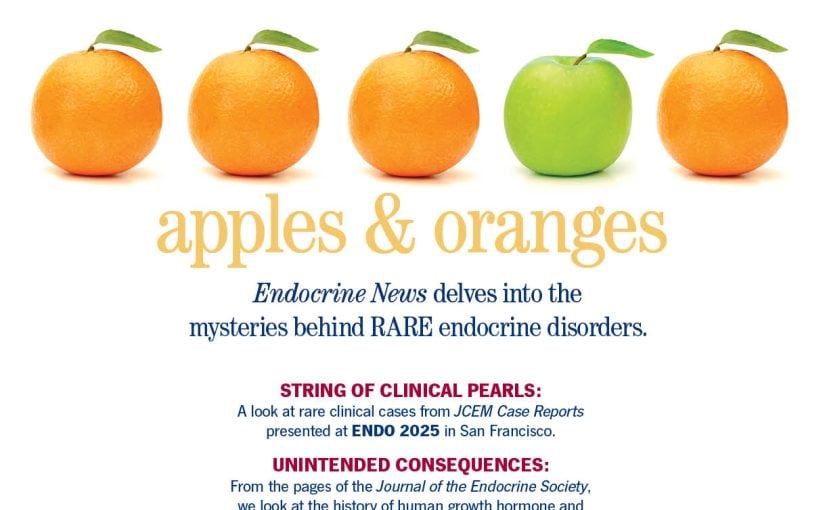One of the most exciting components of the Endocrine Society’s annual conference is the shear amount of cutting-edge research presented by endocrinology researchers from around the world.
ENDO 2021, the very first all-virtual annual conference, is certainly no different in that regard. Studies that could possibly lead to new therapies for a variety of endocrine disorders will be presented. To that end, San Francisco-based pharmaceutical company Spruce Biosciences will be showcasing data from its Phase 1 and 2 programs of tildacerfont in adults with classic congenital adrenal hyperplasia (CAH).
According to the 2015 Endocrine News article, “Heir Apparent: A Multi-Faceted Look at One of the Most Common Inherited Metabolic Disorders, Congenital Adrenal Hyperplasia,” CAH ranks among the most common inherited metabolic disorders, affecting about one in 15,000 newborns. It is characterized by a complex imbalance of steroid hormones, with reduced cortisol and aldosterone synthesis and excessive adrenal androgen production.
Tildacerfont is a highly selective, non-steroidal oral antagonist of the CRF1 receptor, which is the receptor for corticotropin-releasing factor (CRF), a hormone that is secreted by the hypothalamus. The CRF1 receptor is abundantly expressed in the pituitary gland where it is the primary regulator of the HPA axis. By blocking the CRF1 receptor, tildacerfont has the potential to address the uncontrolled cortisol feedback regulatory pathway in CAH, and in turn reduce the production of ACTH in the pituitary, limiting the amount of androgen produced downstream from the adrenal gland. Tildacerfont has been evaluated in 171 patients across seven clinical trials in which it has been generally well tolerated. No drug-related SAEs have been reported related to tildacerfont treatment.
“As an investigator in the SPR001-202 trial, I was pleased to see that the reductions of biomarkers with tildacerfont treatment were not only sustained during the 12 weeks but often progressively greater at the later time points, without any new safety concerns during prolonged treatment,” says Endocrine Society member Rich Auchus, MD, PhD, professor of internal medicine and pharmacology, University of Michigan, Ann Arbor. “These results support ongoing extended studies of tildacerfont for the treatment of classic 21-hydroxylase deficiency.”
Below are the details of the poster sessions:
Poster Session: P04, Adrenal – Basic and Translational Aspects
Abstract Number: 4140
In both single ascending dose and multiple ascending dose studies, tildacerfont was generally safe and well tolerated in healthy adults in single doses up to 800mg as well as in multiple doses up to 200mg once daily, for 14 days. Approximate steady-state exposures were attained within 14 days of dosing.
Further, in a separate bioavailability study, tildacerfont formulated as a tablet provided for a more consistent and more predictable pharmacokinetic profile, as well as demonstrating bioequivalence in overall exposure, compared to a capsule formulation.
Poster Session: P54, Hormone Actions in Tumor Biology: From New Mechanisms to Therapy
Abstract Number: 4305
SPR001-201 was an open-label, multi-dose, dose-escalation study which evaluated the ability of tildacerfont to reduce adrenal hormones and androgens at doses ranging from 200mg daily to 1,000mg daily in patients with congenital adrenal hyperplasia due to 21-hydroxylase deficiency. Participants in the study underwent concurrent salivary and serum concentration measurements of androstenedione (A4), 17-hydroxyprogesterone (17-OHP) and testosterone (T). Both serum and saliva samples were measured using liquid chromatography-tandem mass spectrometry.
The study demonstrated good correlation between salivary and serum assessments of 17-OHP and A4, indicating that measurement of hormones in saliva may offer a promising, non-invasive approach to more frequently assessing response to therapy in patients with CAH.
Poster Session: P25, Endocrine Disrupting Compounds: Mechanisms of Action and Clinical Implications
Abstract Number: 4308
SPR001-202 was an open-label, 12-week Phase 2a clinical trial, which assessed the ability of a daily dose of 400mg of tildacerfont to lower disease-driving hormones such as adrenocorticotropic hormone (ACTH), 17-OHP, and A4 over a 12-week dosing period. Patients were classified into two groups based on disease control using baseline biomarker levels.
Tildacerfont-treated patients with poor disease control had mean maximum reductions of 84% in ACTH, 80% in 17-OHP, and 79% in A4 compared to baseline at 8:00 a.m. This enabled reduction in the levels of these key hormones that are used as targets for assessment of disease control in these patients to near normal levels. In addition, 60% of patients achieved normalization of ACTH levels, and 40% achieved normalization of A4 levels during month three. Normalization of these highly elevated hormones in classic CAH patients within 12 weeks and without increases to daily steroid doses has not been reported to date with any other investigational product candidate. Patients who were in good disease control upon entry to SPR001-202 had mean levels of ACTH, 17-OHP, and A4 that were well below the target goal. Administration of tildacerfont to these patients did not lead to significant changes in these levels.
In the Phase 2 program, comprising of studies SPR001-201 and SPR001-202, two homogenous patient groups were identified using ACTH and A4, which classified these patients as either having “poor disease control” or “good disease control.” Patients with poor disease control had highly elevated ACTH and A4 levels at baseline, generally greater than twice the upper limit of normal (ULN) and, more commonly, greater than four times the ULN. These patients with poor disease control were on a stable mean daily supraphysiologic dose of approximately 25mg of hydrocortisone, or a dose of another glucocorticoid equivalent to 25mg of hydrocortisone. Patients with good disease control had elevated 17-OHP levels but had ACTH and A4 generally less than twice the ULN, and more commonly, within the normal bounds for ACTH and A4. These patients were on doses equivalent to a mean daily supraphysiologic dose 36mg of hydrocortisone, which was a 44% higher total daily dose than patients with poor disease control.
The presentations are now on display in ENDO 2021’s virtual poster hall. Learn more about the full program and how to access the poster presentation details on the ENDO 2021 website.

